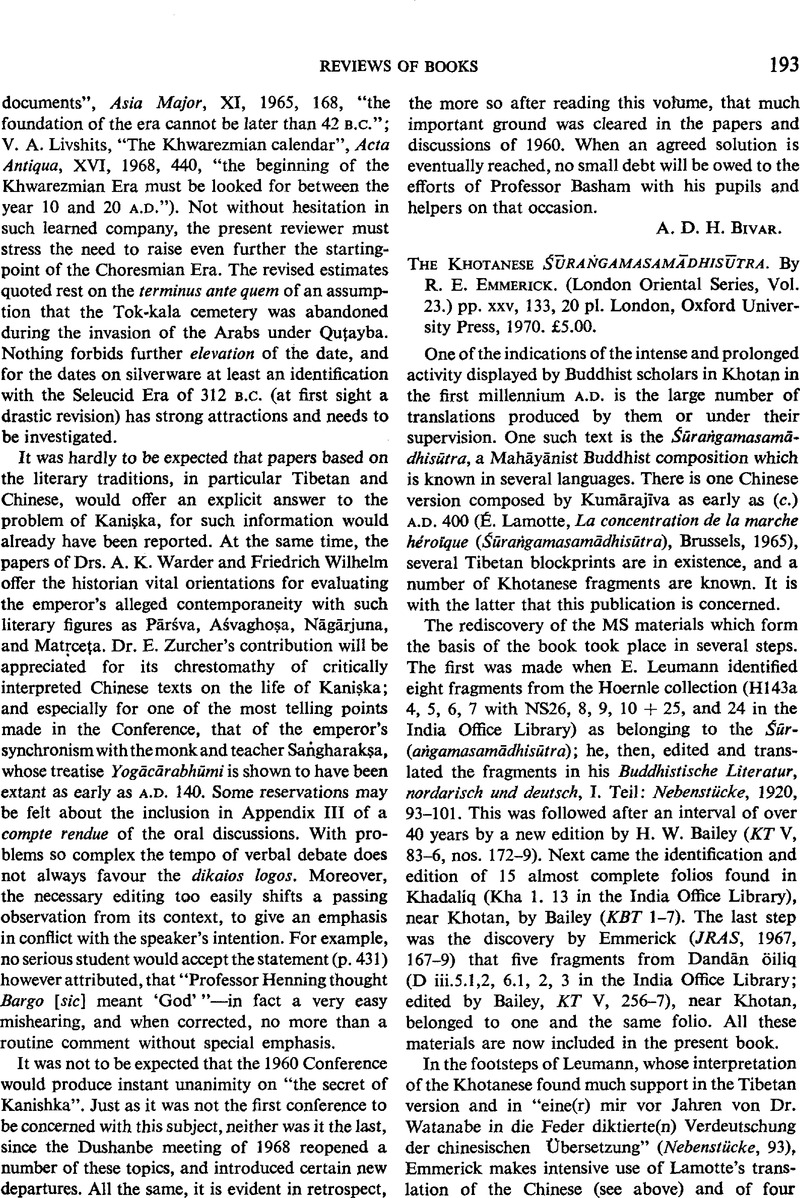No CrossRef data available.
Article contents
The Khotanese Śūraṅgamasamādhisūtra. by R. E. Emmerick. (London Oriental Series, Vol. 23.) pp. xxv, 133, 20 pl. London, Oxford University Press, 1970. £5.00.
Published online by Cambridge University Press: 15 March 2011
Abstract

- Type
- Reviews of Books
- Information
- Copyright
- Copyright © The Royal Asiatic Society 1971
References
1 The book is organized as follows: preface (v–vi), introduction (xiii–xxiii), Khotanese text with English translation (1–49), commentary (51–89), Tibetan text (91–113), Khotanese-Tibetan concordance (114), Tibetan index (115–6; “only a few words of special interest are listed”), Khotanese glossary (117–33; “intended to be complete”).
2 Compare the opening statement of the preface (v), “It is by close study of translation literature that we can hope to make the surest advance in our understanding of an imperfectly-known language”.
3 Ed. and tr. R. E. Emmerick, 1968.
4 Other sections deal with such points as the date of the Śūr., the meaning of the title, other small fragments in Khotanese that may belong to the Śūr., the extant MS materials of the Śūr., and the Tibetan translation.
5 Counter-examples of nom. sg. in -i of -a stems, instead of predominant -ä, besides such cases as gyastä balysi (3.7v 3) and gyasti balysi (3.6r 3) include Indian words and proper names (arthi 3.8r 2, -lovadāti 3.11r 2, vairocani 3.7r 2, śaśivimalagarbhi 3.5v 3, śāriputri 3.7v 2, sarvadevastuti 1.1r 1, sthaviri 3.3r 4), also hotani 3.8r 4; the reverse, gen./dat. sg. in -ä instead of-i in arhandoñä 3.5r 2–3, bäḍä 3.8r 5, patä 3.2r 5, saṃthānä 3.8v 4. It may have been made clear that the two examples of nom./ace. pl. in -i of neuter -n stems are tcei'mañi (2.6r 2) and bva'ñi (2.4r 3) quoted by Leumann (Nebenstücke, 92). The list of verbs showing 3 sg. pres. act. ending -ätä (xix) can be completed by byehätä (2.6r 2).
6 SGS i, 252.
7 SGS, i, 256.
8 Of “rare ” occurrence according to SGS i, 297.
9 “More common” is -äte according to SGS i, 192.
10 -ätä “is never in Z spelled” for -äte, see SGS i, 198.
11 Emmerick is, of course, fully aware of the problems in question; see, for instance, SGS i, xi.
12 The meaning of the expression is discussed on p. 66.
13 See Edgerton, BHS dictionary, 366b.
14 Notice the following: p. 4 2.1v 2 lo]vadātä is followed by a punctuation mark as Bailey (KT V, 83) has it; the italic numerals 6 and 9 on folio (133) are actually at the end, not at the beginning of the corresponding paragraphs, similarly 3, 4, 5, 7, and 8 on folio 145, and 3, 4, 6 on folio 148; p. 85, 1.19, close the parenthesis after KBT 69.




